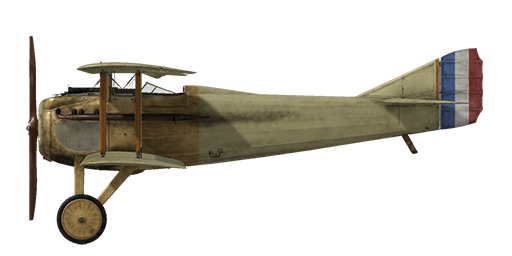il2
SPAD 7.C1 150hp

Description
The SPAD S.VII was a single-seat fighter developed by Louis Bechereau of the Societe Pour L'Aviation et ses Derives in early 1916. Much of the design of the aircraft was drawn from SPAD’s development of the rotary-powered SPAD Type A. The initial engine to equip the SPAD S.VII, the 150-horsepower Hispano-Suiza 8A, was originally developed by Swiss engineer Marc Birkigt in February 1915.
The prototype aircraft, which was called the SPAD V, was flown for the first time in April 1916. This plane initially had a large conical spinner with a central opening, which was blended with a circular radiator and cowling. Although the spinner was eventually discarded, the circular radiator and cowling would remain defining features of the type. Flight testing showed the aircraft possessed an excellent maximum speed and climb rate. In addition, the airframe's sound construction endowed the plane with a diving performance superior to that of the lightly built Nieuports, which were known to shed their lower wings in steep dives. With these promising characteristics in mind, the aircraft was ordered into production as the SPAD S.VII on May 10th, 1916.
Initial delivery of the SPAD S.VII was slow due to difficulties with the production of radiators. Production gradually increased as contracts were given to other French manufacturers (Gremont, Janoir, Kellner, de Marcay, Regy, Societe d'Etudes Aeronautiques, and Sommer). The aircraft was also produced in Russia by Duks and in Great Britain by the Bleriot and Spad Aircraft Works and Mann, Egerton and Company. In early 1917, the 180-horsepower Hispano-Suiza 8Ab began to be fitted to the aircraft, and by April 1917, all newly produced planes were equipped with it. In all, approximately 3,500 SPAD S.VIIs of all types were built.
Over 50 French squadrons were ultimately equipped with the SPAD S.VII, in addition to various Belgian, Italian, Russian, and American units. Owing to the type's sturdiness and excellent reputation as a fighter and the mechanical problems of the SPAD S.XIII, the SPAD S.VII remained in combat service to the end of the war. It remained in the post-war inventories of many nations, and in France, it remained the standard test aircraft for pilot students until 1928.
Engine
V8 Hispano—Suiza 8Aa 150 hp (1450RPM)
Dimensions
Height: 3200 mm
Length: 6080 mm
Wing span: 7822 mm
Wing surface: 17,85 sq.m
Weight
Empty: 500 kg
Takeoff: 705 kg
Fuel capacity: 105 l
Oil capacity: 11 l
Maximum airspeed (IAS)
sea level — 193 km/h
1000 m — 181 km/h
2000 m — 169 km/h
3000 m — 156 km/h
4000 m — 141 km/h
Climb rate
1000 m — 3 min. 8 sec.
2000 m — 6 min. 43 sec.
3000 m — 11 min. 26 sec.
4000 m — 18 min. 22 sec.
Service ceiling 5486 m
Endurance 2 h. 30 min.
Armament
Forward firing: Vickers Mk.I 7.69mm, 500 rounds.
References
1) Aviatik Vintage Aircraft No.1 - Spad 7.C1
2) Windsock Datafile 008 - Spad 7.C1
3) SPAD 150 HP armamento, dec.1917
4) French 'Hispano Suiza' engines tech data.
Modifications
Le Prieur rockets
6 x strut-mounted “Le Prieur” anti-balloon rockets with pointed triangular blade attached to nose cone to assist balloon envelope penetration or additional high explosive filling.
Additional mass: 36 kg
Ammunition mass: 12 kg
Racks mass: 24 kg
Estimated speed loss before launch: 8 km/h
Estimated speed loss after launch: 6 km/h
Lewis Overwing
Cockpit mounted additional Lewis machinegun with changeable position.
Ammo: 291 of 7.69mm rounds (3 drums with 97 rounds in each)
Forward position: 25°
Upward position: 45°
Projectile weight: 11 g
Muzzle velocity: 745 m/s
Rate of fire: 550 rpm
Guns weight: 7.5 kg (w/o ammo drum)
Mounts weight: 0.8 kg
Ammo weight: 12 kg
Total weight: 20.3 kg
Estimated speed loss: 7-18 km/h
Anemometer
E.Badin Anemometer (0..230 km/h at 0 m and 0..240 km/h at 2000 m)
Additional mass: 1 kg
Cockpit light
Cockpit illumination lamp for night sorties
Additional mass: 1 kg
Le-Chretien
Le-Chretien Refractor-type Collimator Sight
Additional mass: 1 kg
Aldis
Aldis Refractor-type Collimator Sight (imported from Britain)
Additional mass: 2 kg